
- English
- ePUB (mobile friendly)
- Available on iOS & Android
eBook - ePub
About this book
"This is the most comprehensive manual written on natural dyes since the early 1800s. Jim Liles has rescued ancient skills from near-extinction and shared them in a book that will inspire, challenge, and guide the modern dyer."—Rita Buchanan, author of A Weaver's Garden and editor of the new Brooklyn Botanic Gardens Handbook on Natural Dyes
" A must for every dyer. The recipes are explicit and detailed as to success and failure."—Mary Frances Davidson
For several thousand years, all dyes were of animal, vegetable, or mineral origin, and many ancient civilizations possessed excellent dye technologies. The first synthetic dye was produced in 1856, and the use of traditional dyes declined rapidly thereafter. By 1915 few nonsynthetics were used by industry or craftspeople. The craft revivals of the 1920s explored traditional methods of natural dyeing to some extent, particularly with wool, although the great eighteenth- and nineteenth-century dye manuals, which recorded the older processes, remained largely forgotten.
In The Art and Craft of Natural Dyeing, J. N. Liles consolidates the lore of the older dyers with his own firsthand experience to produce both a history of natural dyes and a practical manual for using presynthetic era processes on all the natural fibers—cotton, linen, silk, and wool. A general section on dyeing and mordanting and a glossary introduce the beginner to dye technology. In subsequent chapters, Liles summarizes the traditional dye methods available for each major color group. Scores of recipes provide detailed instructions on how to collect ingredients—flowers, weeds, insects, wood, minerals—prepare the dyevat, troubleshoot, and achieve specific shades.
The book will appeal not only to beginning and veteran dyers but also to students of restorations and reconstruction as well as to craftspeople—spinners, quilters, weavers, knitters, and other textile artists—interested in natural dyes for their beauty and historical authenticity.
" A must for every dyer. The recipes are explicit and detailed as to success and failure."—Mary Frances Davidson
For several thousand years, all dyes were of animal, vegetable, or mineral origin, and many ancient civilizations possessed excellent dye technologies. The first synthetic dye was produced in 1856, and the use of traditional dyes declined rapidly thereafter. By 1915 few nonsynthetics were used by industry or craftspeople. The craft revivals of the 1920s explored traditional methods of natural dyeing to some extent, particularly with wool, although the great eighteenth- and nineteenth-century dye manuals, which recorded the older processes, remained largely forgotten.
In The Art and Craft of Natural Dyeing, J. N. Liles consolidates the lore of the older dyers with his own firsthand experience to produce both a history of natural dyes and a practical manual for using presynthetic era processes on all the natural fibers—cotton, linen, silk, and wool. A general section on dyeing and mordanting and a glossary introduce the beginner to dye technology. In subsequent chapters, Liles summarizes the traditional dye methods available for each major color group. Scores of recipes provide detailed instructions on how to collect ingredients—flowers, weeds, insects, wood, minerals—prepare the dyevat, troubleshoot, and achieve specific shades.
The book will appeal not only to beginning and veteran dyers but also to students of restorations and reconstruction as well as to craftspeople—spinners, quilters, weavers, knitters, and other textile artists—interested in natural dyes for their beauty and historical authenticity.
Frequently asked questions
Yes, you can cancel anytime from the Subscription tab in your account settings on the Perlego website. Your subscription will stay active until the end of your current billing period. Learn how to cancel your subscription.
At the moment all of our mobile-responsive ePub books are available to download via the app. Most of our PDFs are also available to download and we're working on making the final remaining ones downloadable now. Learn more here.
Perlego offers two plans: Essential and Complete
- Essential is ideal for learners and professionals who enjoy exploring a wide range of subjects. Access the Essential Library with 800,000+ trusted titles and best-sellers across business, personal growth, and the humanities. Includes unlimited reading time and Standard Read Aloud voice.
- Complete: Perfect for advanced learners and researchers needing full, unrestricted access. Unlock 1.4M+ books across hundreds of subjects, including academic and specialized titles. The Complete Plan also includes advanced features like Premium Read Aloud and Research Assistant.
We are an online textbook subscription service, where you can get access to an entire online library for less than the price of a single book per month. With over 1 million books across 1000+ topics, we’ve got you covered! Learn more here.
Look out for the read-aloud symbol on your next book to see if you can listen to it. The read-aloud tool reads text aloud for you, highlighting the text as it is being read. You can pause it, speed it up and slow it down. Learn more here.
Yes! You can use the Perlego app on both iOS or Android devices to read anytime, anywhere — even offline. Perfect for commutes or when you’re on the go.
Please note we cannot support devices running on iOS 13 and Android 7 or earlier. Learn more about using the app.
Please note we cannot support devices running on iOS 13 and Android 7 or earlier. Learn more about using the app.
Yes, you can access The Art and Craft of Natural Dyeing by J.N. Liles in PDF and/or ePUB format. We have over one million books available in our catalogue for you to explore.
Information
Publisher
University of Tennessee PressYear
2024eBook ISBN
9781621909934Subtopic
BiologyTable of contents
- Cover
- Title Page
- Copyright
- Contents
- Preface
- Acknowledgments
- 1 Introduction
- 2 Dyeing Procedures
- 3 Yellow Dyes
- 4 Blue Dyes
- 5 Red Dyes
- 6 Green Dyes
- 7 Purple Dyes
- 8 Orange Dyes
- 9 Brown Dyes
- 10 Gray and Black Dyes
- Appendixes
- Glossary
- References
- Index